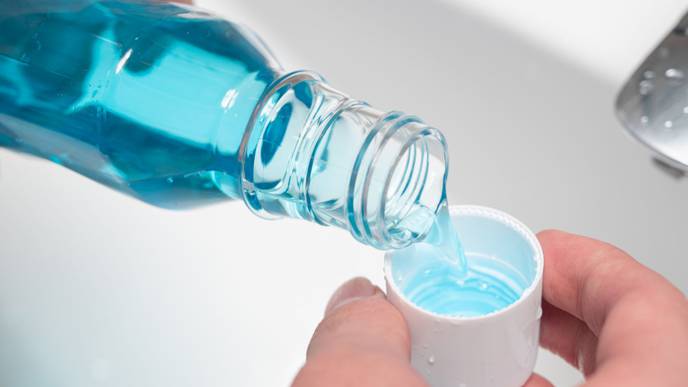ReachMD
Be part of the knowledge.™UB study: Special Mouth Rinse and Brushes Can Help Treat Gum Disease Among Diabetes Patients

BUFFALO, N.Y. – Individuals with Type 2 diabetes being treated for periodontitis may benefit from using an antimicrobial mouth rinse and small brushes to clean between teeth as part of their at-home oral care routine.
This was a key finding in a recent study conducted by Patricia Diaz, DDS, PhD, SUNY Empire Innovation Professor at the University at Buffalo School of Dental Medicine and director of UB’s Microbiome Center. She published the outcomes of the study she conducted with other researchers in the May 6, 2023, issue of JDR Clinical and Translational Research journal.
Scaling and root planing (SRP) is the most commonly used therapy for the initial treatment of periodontitis, or gum disease. However, at-home specialized rinses can also help patients.
“This study aimed to find the effects of an intensive chemical and mechanical antiplaque regiment used at home, in addition to SRP, to treat moderate to severe periodontitis,” Diaz says. “Our secondary objective was to compare the responses in subjects with Type 2 diabetes and those who are nondiabetic.”
The subjects with diabetes who used the mouth rinse showed significantly greater reduction in periodontal inflammation compared with subjects with diabetes receiving the control treatment.
“We’re not sure why exactly, but we suspect it’s because people with diabetes have a weakened healing response,” Diaz says. “This oral care regimen removed oral bacteria and allowed better healing.”
Meanwhile, the nondiabetics did not benefit from the extra measures to remove oral bacteria.
While the dental industry has prescribed antiplaque mouthwashes for patients with periodontitis for years, Diaz notes that no prior studies have been specifically tailored to diabetic patients.
A grant from Sunstar, the manufacturer of several oral care, beauty and health and products, funded the research. Robert J. Genco, SUNY Distinguished Professor of Oral Biology, Periodontics and Microbiology and founder of the UB Microbiome Center, spearheaded the research before his death in 2019.
“Dr. Genco was a pioneer who looked at the relationship between gum disease and systemic disease,” says Diaz. “He had a close working relationship with Sunstar.”
From 2017-20, the research team recruited subjects in Western New York through newspaper advertisements and fliers, particularly encouraging subjects with Type 2 diabetes mellitus to participate.
Out of 361 screened subjects, 114 were selected for participation in the six-month trial. They were then divided into two groups. The test group received nonsurgical periodontal therapy consisting of SRP under local anesthesia and instructions to use a chlorhexidine gluconate mouth rinse twice a day for three months, along with rubber interproximal bristle cleaners twice a day for six months. The other group received SRP and only general oral hygiene instructions.
Chlorhexidine is a potent antimicrobial mouth rinse with superior effectiveness as an antiplaque and antigingivitic agent when compared to other antimicrobial rinses. Practitioners hesitate to use chlorhexidine for extended periods due to side effects, including teeth staining and taste disturbances, Diaz says.
Although subjects reported changes in their taste after three months, this dissipated after they discontinued using the mouth rinse, according to the report. Also, supragingival scaling resolved any staining that resulted from chlorhexidine use.
This study also evaluated changes in blood glucose markers and C-reactive protein (CRP) after periodontal therapy. No changes were observed six months after either treatment in any of the blood biomarkers evaluated.
Diaz says the researchers were surprised that the diabetic subjects responded so well to the home treatments but it also made sense.
“There is lots of talk of precision medicine, and this is one example,” Diaz says. “Before, it had been a one-size-fits-all approach, which isn’t great for treating gum disease.”
While the findings are remarkable, more research is need, Diaz says, adding that she is currently pursuing further study on the microbiome and how it affects diabetes.
“We need more definitive answers,” she says. “Current studies are evaluating what manner this oral care routine modified the oral microbiome to allow for better healing.”
Other UB researchers who contributed to the study included Lu Li, postdoctoral associate in the Department of Oral Biology; Keith Kirkwood, senior associate dean for research in the School of Dental Medicine and Centennial Endowed Chair in the Department of Oral Biology; Robert Schifferle, professor in the departments of Periodontics and Endodontics and Oral Biology; J.J. Zambon, SUNY Distinguished Teaching Professor of Periodontics and Endodontics and former dean of the School of Dental Medicine; Shannon Cervi, registered dental hygienist with the Microbiome Center; and Karen Falkner, associate director of the Microbiome Center. Sunstar researchers were Yoshiko Hayashi-Okada and Yasumitsu Shimizu.
Facebook Comments